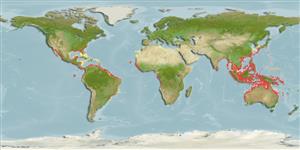Environment: milieu / climate zone / depth range / distribution range
Écologie
marin; eau douce; saumâtre démersal; océanodrome (Ref. 51243); profondeur 25 - ? m (Ref. 114953). Subtropical; 35°N - 40°S, 120°W - 160°E (Ref. 114953)
Circumglobally in tropical and subtropical waters, entering estuaries and littoral lagoons and ascending river courses (Ref. 81284, 81624). Western Atlantic: Florida and Louisiana, USA to Brazil (Ref. 7251); eastern Atlantic: Portugal to Angola, including the western Mediterranean Sea (Ref. 4429; no report since the 19th century [Ref. 116564] ); western Pacific: northern Australia, from western Australia to Queensland (Ref. 7300); eastern Pacific: Gulf of California to Ecuador (Ref. 4429). In freshwater it can be found in rivers of West Africa (Ref. 81284), Ogowe River (Ref. 81284) and the Congo River estuary (Ref. 377, 81284).
Length at first maturity / Taille / Poids / Âge
Maturity: Lm 300.0, range 300 - 300 cm
Max length : 750 cm TL mâle / non sexé; (Ref. 57708); common length : 250 cm TL mâle / non sexé; (Ref. 4429); âge max. reporté: 30 années (Ref. 57533)
Diagnosis: Rostral blade with 20 or fewer pairs of rostral spines (Ref. 81624).
A euryhaline species (Ref. 57533). Inhabits inshore coastal waters to moderate depth, also around off lying islands. Found also in estuaries, lagoons, river mouths, and even freshwater. Feeds on fishes and bottom-living animals. Ovoviviparous. Apparently can reproduce in freshwater (Ref. 57533). Freshwater populations occur to about 750 km up Amazon River; populations in Lake Nicaragua may be non-migratory (Ref. 7251). Reaches sexual maturity at 8-10 years and females have litters of approximately 1-13 pups. Young spend much of their early life in rivers up to 400 km from the sea (Ref. 114953).
Life cycle and mating behavior
Maturité | Reproduction | Frai | Œufs | Fécondité | Larves
Ovoviviparous, embryos feed solely on yolk (Ref. 50449).
Stehmann, M., 1990. Pristidae. p. 51-54. In J.C. Quero, J.C. Hureau, C. Karrer, A. Post and L. Saldanha (eds.) Check-list of the fishes of the eastern tropical Atlantic (CLOFETA). JNICT, Lisbon; SEI, Paris; and UNESCO, Paris. Vol. 1. (Ref. 4429)
Statut dans la liste rouge de l'IUCN (Ref. 130435)
Menace pour l'homme
Harmless
Utilisations par l'homme
Pêcheries: intérêt commercial mineur
Plus d'informations
RéférencesAquacultureProfil d'aquacultureSouchesGénétiqueElectrophoresesHéritabilitéPathologiesTraitementNutrientsMass conversion
Outils
Articles particuliers
Télécharger en XML
Sources Internet
Estimates based on models
Preferred temperature (Ref.
123201): 20.1 - 29.1, mean 27.8 °C (based on 1796 cells).
Phylogenetic diversity index (Ref.
82804): PD
50 = 0.5234 [Uniqueness, from 0.5 = low to 2.0 = high].
Bayesian length-weight: a=0.00501 (0.00198 - 0.01270), b=3.05 (2.83 - 3.27), in cm total length, based on LWR estimates for this (Sub)family-body shape (Ref.
93245).
Niveau trophique (Ref.
69278): 4.0 ±0.60 se; based on food items.
Résilience (Ref.
120179): Faible, temps minimum de doublement de population : 4,5 à 14 années (tmax=44; Fec=1-20;).
Fishing Vulnerability (Ref.
59153): Very high vulnerability (79 of 100).
Nutrients (Ref.
124155): Calcium = 8.73 [1.69, 40.68] mg/100g; Iron = 0.523 [0.130, 1.505] mg/100g; Protein = 20.3 [18.1, 22.3] %; Omega3 = 0.173 [0.070, 0.432] g/100g; Selenium = 37 [10, 113] μg/100g; VitaminA = 2.11 [0.72, 6.06] μg/100g; Zinc = 0.367 [0.179, 0.703] mg/100g (wet weight);
